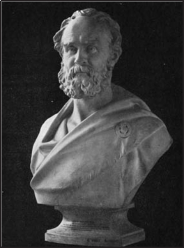- NAPIER D
- UNITED KINGDOM (see also List of Individuals)\
 29.10.1790 Dumbarton/UK - 23.11.1869 London/UK\David Napier's father moved his workshop in 1802 to Glasgow. David recognized the potential of steam navigation and started working with his father at Camlachie where his first machines were a full success. In 1818 he started working of his own fleet with ocean-going steamers. After having made model tests and observations with a steamer in heavy seas to achieve an optimum hull design, he built the Rob Roy to provide services between Greenock and Liverpool. Napier built in 1821 a new works at Lancefield on the Clyde with its own wet dock. There he introduced a number of innovations in the design of both marine engines and propelling machinery including feathering paddles and twin screws. In 1826 he engined the United Kingdom and commissioned the Aglaia, the first iron steamship to be built on the Clyde. John Scott Russell (1808-1882) stated “We believe that from the year 1818 until about 1830 Napier effected more for the improvement of steam navigation than any other man. It is to David Napier that Great Britain owes the establishment of deep-sea communication by steam vessels.”\However, his reputation received a cruel blow in 1835 when the boiler of a steamer exploded in Greenock, killing six people. Napier decided in 1836 to leave Glasgow and join his elder cousin David in London, both to exploit the potential of investigating in shipping on the Thames and to begin iron ship building. He purchased in 1837 an open site on the Isle of Dogs, managed by his sons John and Francis leaving their father time to concentrate on innovative designs. Eclipse, the first iron steamer was launched in 1839. The firm constructed a succession of vessels, incorporating novel features such as rotary engine developed by David Napier. The yard closed in 1852 as it was no longer possible to compete on price with the Clyde. After spending some time in Australia the brothers returned to Glasgow to establish the engineering firm of Napier Bros. Their father David remained in London, continuing his experiments until his death at home.\Anonymous (1912). British steamship centenary. The Marine Engineer and Naval Architect35(1): 4-11. PDay, L., McNeil, I. eds. (1996). Napier, David. Biographical dictionary of the history of technology: 513. Routledge: London.Moss, M.S. (2004). Napier, David. Oxford dictionary of National biography 40: 162-163.University Press: Oxford.Napier, D. (1912). David Napier, engineer: An autobiographical sketch. MacLehose: Glasgow. P
29.10.1790 Dumbarton/UK - 23.11.1869 London/UK\David Napier's father moved his workshop in 1802 to Glasgow. David recognized the potential of steam navigation and started working with his father at Camlachie where his first machines were a full success. In 1818 he started working of his own fleet with ocean-going steamers. After having made model tests and observations with a steamer in heavy seas to achieve an optimum hull design, he built the Rob Roy to provide services between Greenock and Liverpool. Napier built in 1821 a new works at Lancefield on the Clyde with its own wet dock. There he introduced a number of innovations in the design of both marine engines and propelling machinery including feathering paddles and twin screws. In 1826 he engined the United Kingdom and commissioned the Aglaia, the first iron steamship to be built on the Clyde. John Scott Russell (1808-1882) stated “We believe that from the year 1818 until about 1830 Napier effected more for the improvement of steam navigation than any other man. It is to David Napier that Great Britain owes the establishment of deep-sea communication by steam vessels.”\However, his reputation received a cruel blow in 1835 when the boiler of a steamer exploded in Greenock, killing six people. Napier decided in 1836 to leave Glasgow and join his elder cousin David in London, both to exploit the potential of investigating in shipping on the Thames and to begin iron ship building. He purchased in 1837 an open site on the Isle of Dogs, managed by his sons John and Francis leaving their father time to concentrate on innovative designs. Eclipse, the first iron steamer was launched in 1839. The firm constructed a succession of vessels, incorporating novel features such as rotary engine developed by David Napier. The yard closed in 1852 as it was no longer possible to compete on price with the Clyde. After spending some time in Australia the brothers returned to Glasgow to establish the engineering firm of Napier Bros. Their father David remained in London, continuing his experiments until his death at home.\Anonymous (1912). British steamship centenary. The Marine Engineer and Naval Architect35(1): 4-11. PDay, L., McNeil, I. eds. (1996). Napier, David. Biographical dictionary of the history of technology: 513. Routledge: London.Moss, M.S. (2004). Napier, David. Oxford dictionary of National biography 40: 162-163.University Press: Oxford.Napier, D. (1912). David Napier, engineer: An autobiographical sketch. MacLehose: Glasgow. P
Hydraulicians in Europe 1800-2000 . 2013.
